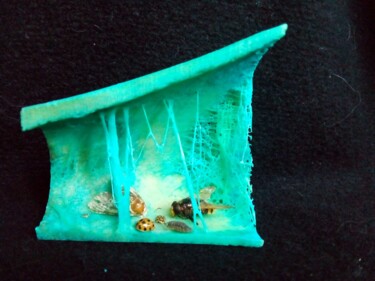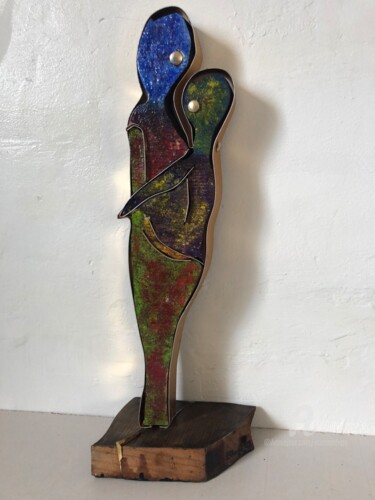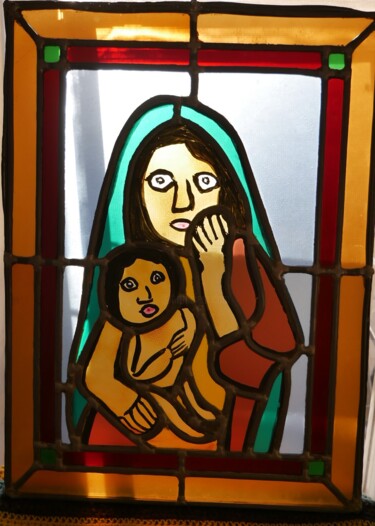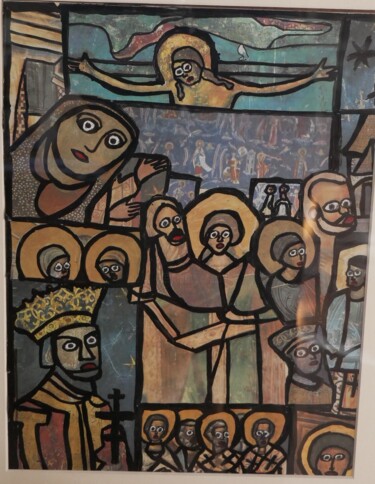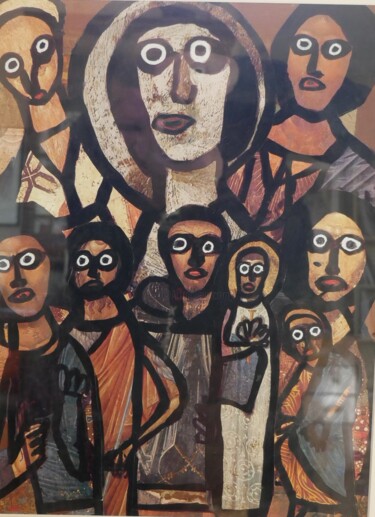8 Oryginalne dzieła sztuki, limitowane edycje i druki:
Ruch artystyczny nierozerwalnie związany z nazwiskiem francuskiego artysty Jeana Dubuffeta, art brut nadal cieszy się pewnym powodzeniem w świecie sztuki współczesnej, o czym świadczy bogata produkcja artystów Artmajeur.
Art brut, czyli outsider art, termin ukuty przez francuskiego artystę Jeana Dubuffeta w 1945 roku, określa tę szczególną formę ekspresji twórczej, głównie twórczość artystów-samouków, dzieci, osób zepchniętych na margines czy pacjentów psychiatrycznych, mającą na celu osiągnięcie swego rodzaju świadomość „różnicy”.
W rzeczywistości efektem twórczości tego szczególnego typu artystów są prace bardzo niezwykłe i instynktowne, które poza określonymi stylami czy nurtami są niezwykle surowe i emocjonalne.
Jaka jest historia sztuki outsiderów?
Wielka wrażliwość i silny podziw, jaki Dubuffet pielęgnował i manifestował wobec „czystości” sztuki zepchniętych na margines, rozwinął się z fundamentalnych spotkań z francuskim mistrzem.
W szczególności na art brut Dubuffeta duży wpływ w głównych koncepcjach miała praca dwóch słynnych psychiatrów, a mianowicie Waltera Morgenthalera i Hansa Prinzhorna, którzy zafascynowani twórczością artystyczną swoich pacjentów zaczęli ją cenić i analizować, gromadzić i dokumentować to.
Właśnie Dubuffet, który zetknął się z tymi studiami, był nimi totalnie zafascynowany, do tego stopnia, że uwierzył, że sztuka chorych psychicznie może reprezentować najczystszą formę twórczości artystycznej.
W szczególności jedna książka, Bildnerei der Geisteskranken Prinzhorna, w której przeanalizowano tysiące dzieł sztuki wykonanych przez osoby chore psychicznie w różnych instytucjach europejskich, wpłynęła na jego pogląd na sztukę.
To właśnie po przeczytaniu tej pracy Dubuffet rozpoczął swoją osobistą kolekcję, obejmującą nie tylko sztukę stworzoną przez chorych psychicznie, ale także twórczość ekscentryków, dzieci, odmieńców i wyrzutków.
Kolekcja ta, zwana „La Collection de l'Art Brut”, została następnie podarowana przez Jeana Dubuffeta miastu Lozannie (Szwajcaria), gdzie jest rozwijana do dziś. Prace prezentowane w ramach wystaw stałych lub czasowych mają na celu zachęcenie zwiedzających do zastanowienia się i zrozumienia tych artystów, którzy tak naprawdę artystami nie są.
Jakie są najczęstsze techniki ruchu artystycznego Outsider Art?
W rzeczywistości nie ma reprezentatywnych technik sztuki outsiderów, ponieważ każdy artysta w tym ruchu ma tendencję do autonomicznego wyrażania swojego wnętrza, zgodnie z najbardziej naturalną, prostą, bezpośrednią i instynktowną tendencją. Rzeczywiście, prace można tworzyć na wielu różnych nośnikach, takich jak papier, karton, karton, ściana, płótno, miedź i szkło.
Jednak w pracach tego typu artystów często można znaleźć pewne powtarzające się cechy stylistyczne, takie jak motywy i szczególne metody projektowania, które są bardzo obsesyjne i powtarzalne.
Prawdopodobnie te sposoby podejścia do sztuki ujawniają zarówno głęboką wrażliwość na upływ czasu, jak i chęć stworzenia swego rodzaju ładu w często problematycznej i chaotycznej przestrzeni wewnętrznej.
Jeśli chodzi o użyte materiały, są one, podobnie jak ich twórcy, często niekonwencjonalne, jakby chciały bardziej połączyć się z bogatym wewnętrznym światem ich twórcy.
Kim są znani artyści i dzieła?
Jean Dubuffet (1901 - 1985)
Jean Dubuffet, słynny francuski malarz i rzeźbiarz, uważany jest za twórcę ruchu artystycznego Art Brut. Po dwóch latach uczęszczania do Akademii Sztuk Pięknych w Le Havre, jego rodzinnym mieście, wyjechał w 1918 roku do Paryża, aby wziąć udział w kursach w Académie Julian, instytucji, którą opuścił dopiero sześć miesięcy później. . W tym okresie formacyjnym duży wpływ wywarła na niego książka Hansa Prinzhorna o sztuce obłąkanych i twórczości artystycznej ludów prymitywnych. Jednak jego decyzja o zostaniu malarzem stała się ostateczna dopiero w 1942 roku, kiedy to duży wpływ na niego wywarł ekspresjonistyczny mistrz Paul Klee. Ale dopiero od 1945 roku rozpoczęła się jego prawdziwa droga, w okresie, w którym Dubuffet teoretyzował i wprowadził pojęcie art brut. Zawsze w zgodzie z tym prądem artystycznym, założył w 1947 roku, wraz z André Bretonem, Paulhanem i Drouinem, „Compagnie de l'art brut”. To właśnie w tych ostatnich projektach pojawiła się z mocą myśl Dubuffeta: uwolnić się od tradycji artystycznej, szukać oryginalnej twórczości zdolnej wytyczyć nową drogę dla sztuki.
Adolfa Wölfliego (1864 - 1930)
Adolfa Wölfli, szwajcarskiego malarza i głównego przedstawiciela Art Brut, w dużej mierze naznaczyły nieprzyjemne wydarzenia z dzieciństwa, rozbite na zawsze obecnością brutalnego ojca i przedwczesną śmiercią matki. Te nieprzyjemne wydarzenia, w połączeniu ze złym traktowaniem, jakiego doznał młody człowiek podczas pracy w obozach, doprowadziły chłopca do poważnych problemów behawioralnych, do tego stopnia, że najpierw trafił do więzienia, a następnie, po udowodnionym stanie schizofrenii, został internowany w azylu Waldau (Szwajcaria), gdzie pozostanie do końca swoich dni. To właśnie w szpitalu psychiatrycznym artysta pocieszał się rysowaniem, stopniowo uświadamiając sobie swój talent, do czego gorąco zachęcał i cenił psychiatra Walter Morgenthaler. Na koniec warto podkreślić, w jaki sposób artysta stworzył w ciągu trzydziestu lat działalności 1300 rysunków, kilka zeszytów pisarskich i gigantyczną biografię w liczbie nie mniejszej niż 25 000 egzemplarzy (Legenda o św. Muzeum Sztuk Pięknych w Bernie.
Henry Darger (1892 - 1973)
Henry Darger, amerykański pisarz i ilustrator, jest najbardziej znany ze swojego fantastycznego rękopisu, zatytułowanego The Realms of Unreal, bogato ilustrowanego niektórymi z najlepszych przykładów sztuki outsiderów wykonanej akwarelą. Jeśli chodzi o życie artysty, Darger, po stracie matki w wieku czterech lat, mieszkał z troskliwym ojcem, dopóki ten ostatni, wiekowy i niepełnosprawny, nie został przewieziony do domu spokojnej starości. Po tym epizodzie trafił najpierw do katolickiego domu dziecka dla młodych ludzi, a potem został przeniesiony do szpitala psychiatrycznego, bo uznano go za chorego psychicznie. Cierpienie tego uwięzienia zostało w dużej mierze wysublimowane w dziele literackim Les filles de Vivian. W 1908 roku Dargerowi udaje się uciec ze szpitala psychiatrycznego, ale smak jego wolności naznaczony jest silną egzystencjalną monotonią.
Howarda Finstera (1916-2001)
Howard Finster , amerykański artysta baptysta i pastor, twierdził, że Bóg zainspirował go do szerzenia ewangelii poprzez swoją twórczość artystyczną, w tym dzieła outsiderów, naiwnych i wizjonerskich. Artystyczne poszukiwania Finstera dały się poznać szerszej publiczności w latach 80., kiedy to zaprojektował okładki albumów słynnych amerykańskich grup REM i Talking Heads. Jeśli chodzi o życie prywatne artysty, Finster, który urodził się w Alabamie i dorastał na farmie swojej dużej rodziny, miał swoją pierwszą wizję w wieku trzynastu lat, niezwykle pouczający epizod, który doprowadził go do oddania się głoszeniu kazań. Jeśli chodzi o karierę artystyczną, poświęcił się budowie muzeów, których celem było gromadzenie i eksponowanie okazów tego, co stworzyła ludzkość, jak np.
Discover contemporary artworks on Artmajeur
Contemporary art is a vibrant constellation of artistic expressions. This creative universe encompasses a wide array of mediums, from paintings, sculpture, and photography to drawing, printmaking, textile art, and digital art, each medium a star shining with its own distinct radiance. Artists use diverse supports and materials to bring their visions to life, such as canvas, wood, metal, and even innovative digital canvases for the creation of virtual masterpieces.
A contemporary painting, for instance, may weave its story through the masterful strokes of acrylic or oil, while a contemporary sculpture might sing its song in the language of stone, bronze, or found objects. The photographic arts capture and manipulate light to produce striking images, while printmaking employs techniques like lithography and screen-printing to produce multiples of a single, impactful image. Textile art plays with fabrics and fibers, whereas digital art pushes the boundaries of creation with innovative technology.
The allure of contemporary art lies in its boundary-pushing nature, its relentless quest for experimentation and its constant reflection of the evolving human experience. This boundless creativity, coupled with its strong social and personal commentary, makes every piece of contemporary art a unique emblem of its time, a mirror held up to the realities and dreams of our complex world. It whispers to us, moves us, provokes thought, and kindles a deep emotional response, stirring the soul of anyone willing to listen. It is, indeed, the language of emotions and ideas, spoken in the dialect of our era.

©2022 Lionel Le Jeune
Origins and history of contemporary art
The story of contemporary art unfolds in the mid-20th century, marked by seismic shifts in artistic expression. Post-World War II, around the 1950s and 1960s, artists began experimenting beyond traditional confines, challenging the norms of what art could be. This revolutionary epoch birthed myriad new movements and artistic forms such as abstract expressionism, pop art, and minimalism. Paintings, once confined by realism, embraced abstraction, as artists used color and form to express emotions and ideas. Notable periods like the advent of pop art in the late 1950s and early 1960s saw artworks mimicking popular culture and mass media, reflecting society’s shifting focus.
The sculptural arts, too, witnessed a metamorphosis. Sculptors started to experiment with new materials and forms, often creating artworks that interacted with the viewer and the surrounding space, fostering a sense of engagement. Drawing, a timeless practice, also evolved, with artists incorporating innovative techniques and concepts to redefine its role in contemporary art.
Photography, a relatively new medium, emerged as a powerful tool in the contemporary art landscape. Born in the 19th century, it truly came into its own in the latter half of the 20th century, blurring the lines between fine art and documentation. Printmaking, a practice dating back to ancient times, saw renewed interest and experimentation with techniques like lithography, etching, and screen printing gaining prominence.
The realm of textile art expanded dramatically, as artists began to appreciate the versatility and tactile quality of fabric and fibers. Artists began using textiles to challenge the boundaries between fine art, craft, and design.
The dawn of digital technology in the late 20th century heralded a new age for contemporary art. Digital art emerged as artists started leveraging new technologies to create immersive, interactive experiences, often blurring the line between the virtual and the physical world.
Through these transformative periods, the essence of contemporary art has remained the same: a dynamic, evolving reflection of the times we live in, continually pushing boundaries and embracing the new, always questioning, always exploring.
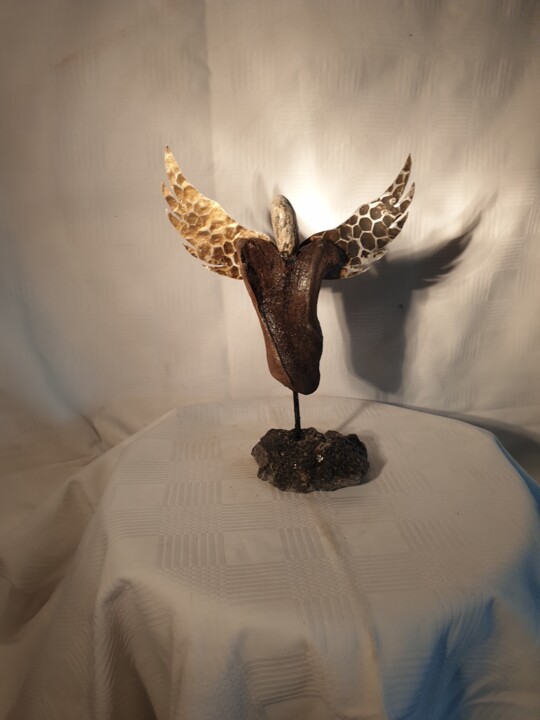
©2023 Charly Carpentier
Evolutions of theses contemporary works in the art market
As we navigate through the 21st century, the dynamic landscape of contemporary art continues to evolve and expand, reflecting our ever-changing world. Contemporary paintings, once primarily confined to two-dimensional canvases, now embrace a multitude of forms and techniques, ranging from mixed media installations to digital creations, each piece a rich a weaving of thoughts, emotions, and narratives. Sculpture, too, has ventured far beyond traditional stone and bronze, with artists incorporating light, sound, and even motion, embodying the ephemerality and flux of the modern world.
Photography, in the hands of contemporary artists, has expanded its horizons, seamlessly blending with digital technology to create breathtaking imagery that challenges our perception of reality. Drawing, as well, has transcended the borders of paper, incorporating multimedia elements and exploratory techniques to redefine its role in the artistic discourse. Printmaking continues to flourish, with contemporary artists using traditional methods in innovative ways to deliver potent social and personal commentaries.
Textile art, once considered a craft, now holds a prominent place in the contemporary art world, with artists using it to explore issues of identity, tradition, and cultural heritage. Meanwhile, digital art, the newest member of the contemporary art family, has revolutionized the way we create and interact with art, presenting immersive experiences that blur the boundary between the virtual and the physical.
These diverse forms of contemporary art hold significant value in the current art market, not only due to their aesthetic appeal but also their ability to encapsulate and communicate complex ideas and emotions. Collectors, curators, and art lovers worldwide seek these works, drawn to their inherent dynamism, their innovative use of materials, and their eloquent expressions of our shared human experience. As a testimonial to our times, these contemporary artworks encapsulate the pulse of our society and the resonance of individual voices, forever etching our collective narrative into the annals of art history.

©2019 Adam Nidzgorski
Famous Contemporary Artists
As we delve into the vibrant realm of contemporary art, we encounter an array of artists who shape this dynamic field. Each a master in their medium - painting, sculpture, photography, drawing, printmaking, textile, or digital art - they push artistic boundaries, reflecting our era and challenging perceptions. Let’s explore these remarkable contributors and their groundbreaking works.
1. Gerhard Richter - Known for his multi-faceted approach to painting, Richter challenges the boundaries of the medium, masterfully oscillating between abstract and photorealistic styles. His works, whether featuring squeegee-pulled pigments or blurred photographic images, engage in a fascinating dialogue with perception.
2. Jeff Koons - A significant figure in contemporary sculpture, Koons crafts monumental pieces that explore themes of consumerism, taste, and popular culture. His iconic balloon animals, constructed in mirror-polished stainless steel, captivate with their playful yet profound commentary.
3. Cindy Sherman - An acclaimed photographer, Sherman uses her lens to explore identity and societal roles, particularly of women. Renowned for her conceptual self-portraits, she assumes myriad characters, pushing the boundaries of photography as a medium of artistic expression.
4. David Hockney - Hockney, with his prolific output spanning six decades, is a pivotal figure in contemporary drawing. His bold use of color and playful exploration of perspective convey an intoxicating sense of joy and an unabashed celebration of life.
5. Kiki Smith - An innovative printmaker, Smith’s work explores the human condition, particularly the female body and its social and cultural connotations. Her etchings and lithographs speak to universal experiences of life, death, and transformation.
6. El Anatsui - A master of textile art, Anatsui creates stunning tapestry-like installations from discarded bottle caps and aluminum scraps. These shimmering, flexible sculptures blend traditional African aesthetic with contemporary art sensibilities, speaking to themes of consumption, waste, and the interconnectedness of our world.
7. Rafael Lozano-Hemmer - A leading figure in digital art, Lozano-Hemmer utilizes technology to create interactive installations that blend architecture and performance art. His work, often participatory in nature, explores themes of surveillance, privacy, and the relationship between people and their environments.
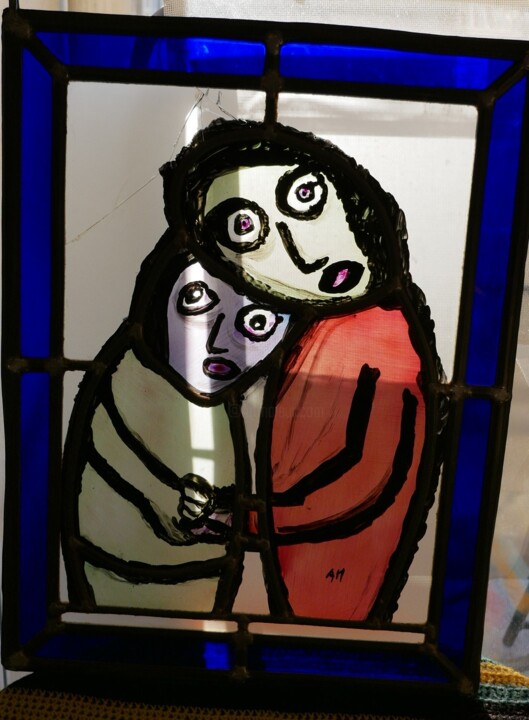
©2010 Adam Nidzgorski
Notable contemporary artworks
The contemporary art landscape is a dynamic patchwork of diverse expressions and groundbreaking ideas, each artwork a unique dialog with its audience. Here are a selection of some renowned contemporary artworks, spanning various media such as painting, sculpture, photography, drawing, printmaking, textile art, and digital art, that have profoundly influenced this vibrant movement.
"Cloud Gate" by Anish Kapoor, 2006 - This monumental stainless steel sculpture, also known as "The Bean," mirrors and distorts the Chicago skyline and onlookers in its seamless, liquid-like surface, creating an interactive experience that blurs the line between the artwork and the viewer.
"Marilyn Diptych" by Andy Warhol, 1962 - An iconic piece of pop art, this silkscreen painting features fifty images of Marilyn Monroe. Half brightly colored, half in black and white, it reflects the dichotomy of celebrity life and its influence on popular culture.
"Rhein II" by Andreas Gursky, 1999 - This photographic artwork, a digitally-altered image of the Rhine River, is celebrated for its minimalist aesthetic. It strips the landscape to its bare essentials, invoking a sense of tranquility and vastness.
"Black Square" by Kazimir Malevich, 1915 - A revolutionary painting in the realm of abstract art, this piece, featuring nothing more than a black square on a white field, challenges traditional notions of representation, symbolizing a new era in artistic expression.
"Puppy" by Jeff Koons, 1992 - This giant sculpture, a West Highland Terrier blanketed in flowering plants, explores themes of innocence, consumer culture, and the interplay between high art and kitsch. It’s a delightful blend of traditional sculpture and garden craft.
"Re-projection: Hoerengracht" by Ed and Nancy Kienholz, 1983-1988 - A room-sized tableau representing Amsterdam’s red-light district, this work combines elements of sculpture, painting, lighting, and found objects. It engages viewers in a stark commentary on commodification and objectification.
"Untitled" (Your body is a battleground) by Barbara Kruger, 1989 - This photomontage, combining black-and-white photography with impactful text, explores issues of feminism, identity, and power. Its potent, confrontational message is a prime example of the power of text in contemporary visual art.
"For the Love of God" by Damien Hirst, 2007 - This sculpture, a platinum cast of a human skull encrusted with 8,601 diamonds, probes themes of mortality, value, and the human fascination with luxury and decadence. It’s a compelling blend of macabre and magnificence.
"Physical impossibility of Death in the Mind of Someone Living" by Damien Hirst, 1991 - This artwork, featuring a tiger shark preserved in formaldehyde, blurs the line between traditional sculpture and biological specimen. It prompts viewers to contemplate mortality and nature’s ferocity.
"One and Three Chairs" by Joseph Kosuth, 1965 - A piece of conceptual art, it presents a physical chair, a photograph of a chair, and a dictionary definition of a chair, thus exploring the relationship between language, picture, and referent in art.
These pieces, in their diversity, exemplify the rich tapestry of contemporary art, each piece a unique commentary on our world and a testament to the limitless potential of creative expression.
